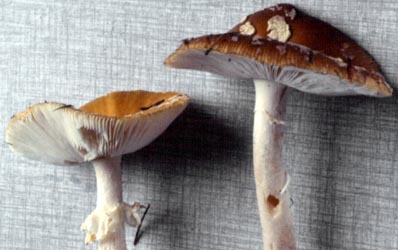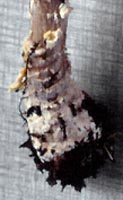|
Amanita regalis (Fr.)
Michael "King of Sweden Amanita"
Technical description (t.b.d.) BRIEF DESCRIPTION: The following description is based on Bresinsky and Besl (1990), Gulden et al. (1989), and from personal collections of Tulloss. The cap of Amanita regalis is 70 - 160 (-200) mm wide, 4 - 12 (or more) mm thick dark umber, olive ochre-yellow, ochre-brown, grayish yellow to light nut-brown, glutinous, shiny, subglobose when young, then convex, finally nearly planar with a slightly depressed center, with a nonappendiculate and subtubercular striate margin in maturity (about 10 - 20% of cap radius), which can flare up in age. Over the disc of an opened specimen, the color varied from dark golden brown, brown-orange, to yellow brown; away from the center, the cap was golden brown, brownish orange-yellow to tannish cream at the very margin. The cap color fades slightly with age, no matter what colors it develops before then. The buttons can be almost a pure yellow or an intense dark brown. The volva is present in young material as a tomentose, pulverulent veil that is always yellowish to yellowish-gray and easily separated from the surface of the cap. At first, the volva is bright yellow and rapidly becomes pallid to whitish in sunlight. In age, the warts may darken with gray tints. In mature material, the warts are floccose-pulverulent, friable, and vary in size. The warts are distributed densely but irregularly unless washed off by rain. The cap skin is removable as far as the center. The flesh is fairly intense yellow brown to olive-ocher to olive-brown immediately below the skin, faint yellowish white to pale yellow in the rest of the flesh. Gills are free, sometimes narrowly attached to the stem at first, crowded to subcrowded, cream in mass, cream to pale yellowish cream to white with a dingy ochraceous tint, 6 - 9 mm broad, with a convex-floccose edge. The short gills are truncate, plentiful, unevenly distributed, and of several lengths. The stem is 90 - 200 × 9 - 25 mm,
narrowing upward, minimally flaring at the top of The odor is indistinct. The spores measurements provided by Bresinsky and Besl (1990) are as follows: 9 - 12 × 6 - 9 µm and are broadly ellipsoid to ellipsoid and inamyloid. Tulloss' measurements from Finnish, Norwegian, and Swedish material are (8.1-) 9.0 - 11.1 (-16.7) × (6.5-) 6.7 - 8.7 (-12.0) and are broadly ellipsoid to ellipsoid (rarely elongate) and inamyloid. Clamps are present at bases of basidia. The present species occurs in damp, partly grassy, pine and spruce forests as well as deciduous forests (including birch) in the mountains of Central Europe and Northern Europe as well as in Scandinavia. The species is reported to have a montane distribution in Japan (Oda et al., 2004). In North America, the species occurs mostly above treeline in Alaska (J. Geml, personal corresp.). Amanita regalis is poisonous. It contains toxins present in other species similar to A. muscaria (L. : Fr.) Lam., A. pantherina (DC. : Fr.) Krombh., A. crenulata Peck, etc. Amanita regalis has
been at times been considered a variety of Amanita muscaria; but the unusual range of color is very consistent; and
Scandinavian mycologists who know it well consider it a separate
species with no evidence of interbreeding with A. muscaria. It
seems to have a more limited and northerly range than does A. muscaria
despite the fact that the two ranges substantially overlap. As would
be supposed by anyone observing the distribution of the volva on the
stem and bulb this species is in fact a close relative of A.
muscaria. In addition to the form of the volva, the fact that both
taxa have plentiful clamps on their basidia links them into a rather
well defined subgroup of section Amanita. To date I don't know
of evidence that A. regalis has been exported with trees to
other continents. In this it is strikingly different from A.
muscaria. For more information on this point, see Amanita
muscaria. Photos: R. E. Tulloss (Norway. Note: We'd be very pleased to receive better photographs and especially if accompanied by a dried specimen from the collection pictured in those photographs). Return to Section Amanita page. Last changed 13 September 2007. |


 the stem,
fibrillose-tomentose, white to pale yellowish white, and
sometimes discoloring brown to ochraceous-olive with handling, sometimes
decorated with upward pointing concolorous, fibrillose scales. The ring is floccose,
off-white, not striate on the surface, thin, membranous, skirt-like,
persistent, and in the upper one-third to one-half of the stem. It bears yellowish to
brownish yellow floccose scales on the underside. The bulb is 15 - 35 mm
wide, subglobose to ovoid, white, tapering towards the base, with two to
eight or more bands of yellowish flocci and scales (see adjacent
illustration). These rings of
material become grayish-cream with age. Bits of the volva in its whole
range of coloration can be found distributed unevenly over the lower
stem and are often seen in the substrate when the mushroom is removed.
The central cylinder of the stem is at first firmly packed with white
cottony material which eventually disappears making the stem hollow.
The central cylinder comprises 25 - 30% of the stem's diameter. The
flesh is white to off-white or yellowish below the ring, sometimes with watery
streaks.
the stem,
fibrillose-tomentose, white to pale yellowish white, and
sometimes discoloring brown to ochraceous-olive with handling, sometimes
decorated with upward pointing concolorous, fibrillose scales. The ring is floccose,
off-white, not striate on the surface, thin, membranous, skirt-like,
persistent, and in the upper one-third to one-half of the stem. It bears yellowish to
brownish yellow floccose scales on the underside. The bulb is 15 - 35 mm
wide, subglobose to ovoid, white, tapering towards the base, with two to
eight or more bands of yellowish flocci and scales (see adjacent
illustration). These rings of
material become grayish-cream with age. Bits of the volva in its whole
range of coloration can be found distributed unevenly over the lower
stem and are often seen in the substrate when the mushroom is removed.
The central cylinder of the stem is at first firmly packed with white
cottony material which eventually disappears making the stem hollow.
The central cylinder comprises 25 - 30% of the stem's diameter. The
flesh is white to off-white or yellowish below the ring, sometimes with watery
streaks.